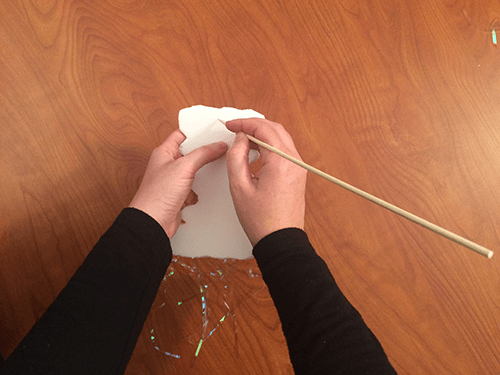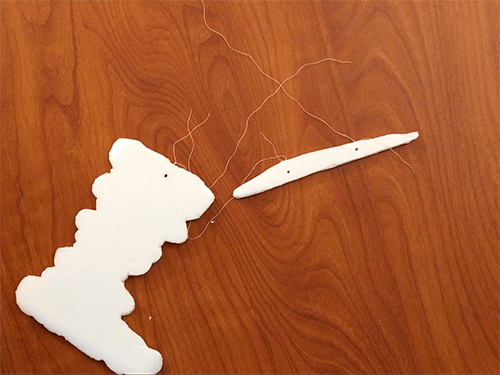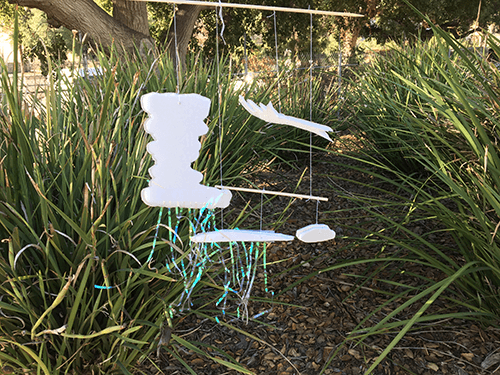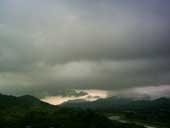Watch this video to learn how to make a cloud mobile!
This mobile of feathery clouds will twist and turn in a gentle breeze. It even includes rain clouds with sparkling showers!
You’ll have four kinds of clouds in your mobile: Cumulonimbus, cirrus, cumulus, and nimbostratus clouds. These clouds are different shapes, and they can mean very different things for the upcoming weather. Learn all about these clouds in the green bar on the right!
To make this cloud mobile, you’ll need a few easy-to-find supplies—and a little patience to get the clouds balanced just right.
What you need:

- 2 or 3 large Styrofoam take-out boxes or pieces of white cardboard
- 2 thin, lightweight sticks (like wooden skewers); one stick should be about 12 inches long and the other should be 8 inches long
- Mylar shred (such as used for gift baskets)
- White sewing thread or lightweight string
- Scissors
- Pencil
- Clear tape
- Download cloud patterns
What to do:
- Use scissors to cut out the paper cloud patterns.
- Place the paper cloud shapes on top of the Styrofoam boxes or cardboard and trace around them with the pencil.
- Use the scissors to cut the cloud shapes from the Styrofoam or cardboard.
- Find the cumulonimbus and nimbostratus cloud shapes. These are the two types of rain clouds. To make rain, fold the mylar shred in half and tape the pieces to the bottom of the cloud.
- Use the point of the pencil or skewer to poke holes in the tops of each of the clouds. These are the holes you’ll use to hang the clouds from the skewers. Some of the longer clouds (such as the nimbostratus cloud) will need two holes to help them balance while hanging.
- Cut 10 to 12 pieces of thread that are each approximately 15 inches long. Weave a piece of thread through one of the holes in the Styrofoam cloud shape. Tie a knot in the thread to secure the cloud on the thread. Repeat this step until there is a piece of thread knotted in every hole in the clouds.
- The cirrus and cumulonimbus clouds go highest in the atmosphere; tie the free end of the thread from each of those clouds to the long skewer.
- The nimbostratus and cumulus clouds are lower in the atmosphere; tie those clouds to the short skewer.
Tip: If you used two pieces of thread in the long, nimbostratus cloud, be sure that both pieces of thread are tied to the skewer at approximately the same length. This will help to keep the cloud level. - Use two pieces of thread and tie the ends of the short skewer to two points on the long skewer. The short skewer (and the clouds that are lowest in the atmosphere) will hang below the long skewer.
Tip: You might have to try several hanging spots to get the clouds to hang level. - Now, tie a thread near the center of the long stick. Again, you may have to experiment to find the right spot to balance the weight of the mobile. Use this thread to hang the mobile somewhere that it can dance freely in the breeze!










FUN FACT: Real cumulonimbus clouds can reach as high as 40,000 feet! Our cumulonimbus reaches from the lowest altitude, which it shares with the rainy nimbostratus cloud, all the way up to the highest cirrus clouds.


Download a PDF of this activity.
Seeing through the clouds

CloudSat is an Earth satellite that studies the clouds in ways never before possible. CloudSat's instrument can see what’s inside the clouds. It sends out radar signals that bounce off the water in the clouds and then bounce back to the CloudSat instrument. This signal tells CloudSat how thick the clouds are and how much water they contain.
Knowing how clouds affect Earth's climate is very important. Do clouds trap heat and make Earth's surface warmer? Or do clouds' bright surfaces reflect enough sunlight back into space to make up for the heat they trap? These questions must be answered for scientists to be able to predict how Earth's climate may change.
Here is a CloudSat poster showing all the cloud types and comparing their altitudes in the sky.
Related Resources for Educators
Our World: Cloud Inspection
Clouds (Educator Guide for Clouds Spotlite video)
Clouds (Nearpod Lesson to go with Clouds Spotlite video)
Our World: What Is a Cloud?
Our World: Cool Clouds










